Last week we learned all about woven fabrics, and, this week we're moving onto knits! But, I want to do something a little different for this lesson. If you have been following along with my TEXTILES 101 mini-series, hopefully by this point things are really starting to come together. So this week we are going to take everything that we have learned, along with some new knitting info and determine what is the best white t-shirt on the market. It turns out all you need to know are the very fundamentals of knitting to figure out if you are buying a quality product or garbage that a marketing team made you think sounded fancy.
And, if you find yourself obsessed with knits. Next week we will dive deeper into knits, and cover more advanced techniques.
The Best White T-shirt - Top Contenders
Every couple of years, the fashion industry becomes obsessed with the perfect white t-shirt. To this, all of us in the industry roll our eyes. What is the industries obsession? Probably because t-shirts have one of the best margins. The fabric is cheap, and they are quick to produce.
And, those brands selling you “premium” t-shirts with the perfect fit, and fabric they claim they spent years researching? Don’t buy into their hype. We are going to break down what it is you are really buying.
Best white t-shirts in the running...
Here are our best white t-shirt contenders. I have listed them in alphabetical order to reduce as much bias as possible. Before you start reading, rank the shirts from the worst quality to best. Don’t cheat and skip ahead!

Everlane - $30
The Organic Cotton Slouchy V-Neck
Hanes - 3 for $17 ($5.66/shirt)
(while technically this is a men’s shirt, I am sure you could find one or two in most women's closets).
Madewell - $19.50
Whisper Cotton V-Neck Pocket T
RE/DONE - $73
Uniqlo - $9.90
Women Supima Cotton V-Neck T-Shirt
BUT BEFORE WE GET STARTED...
I love helping startup brand founders succeed, so I created a bunch of free guides that will help you with your business.
They won’t be free forever, so make sure to grab them while you can.
- CUT YOUR SOURCING TIME IN ½ - the industry sourcing doc you didn’t know existed but definitely need
- HOW MUCH DOES IT REALLY COST TO START YOUR BRAND – I have helped people with as little as $2,500 get started; here’s how…
- NO MORE EXCUSES – get the exact productivity system I use to get things done
What are knits?
To put it simply, while weaving is the intersection and overlap of yarns, the process of knitting, loops yarns together to create fabric.
Whenever I meet someone new and tell them what I do, textiles, the first thing they ask is – can you knit me a sweater? Umm, no. And, that’s not even how all of this works! It is amazing to me how many people think every sweater that they buy in a store is knit by hand by a person, like a granny sitting in a rocking chair with two needles. Nope. In reality, a machine makes your sweater
So, let’s dive into the complex world of industrial machine knitting.
Knit fabrics form by yarn loops connecting. But, just how does this happen? First, let’s get some basic terms down.
A stitch
This is the intersection where two loop cross.
Wales
Wales are the columns in a knit fabric. They are similar to the warp in a woven fabric.
Wales Per Inch measures how many loops are vertically in 1” inch of fabric.
Courses
The rows of stitches in a knit fabric are courses. They are similar to the weft yarns in a woven fabric. Course per Inch measure how many loops or stitches are horizontally in 1” of fabric.
How to hold a knit fabric
Just like a woven fabric, there is technically a right and wrong way to hold a knit fabric.
Technical face and back
And again, just like woven fabrics knit fabrics also have a technical face and back. The face of a fabric is the side with the most knit stitches, with purls on the back.
Up and down
V for victory. This will forever be stuck in my head. One of my fav professors at FIT would say this all the time. This means that when you look at a knit fabric the stitches should form a “v” shape. If they do, you are holding the fabric in the correct direction. The "v" shape also signals that you are looking at the knit side (not the purl side) of a stitch.
Types of Knit Fabric Stitches
There are four main types of knit stitches. They are knit, purl, miss, and tuck. Combining these 4 stitches in different ways can create infinite fabric designs. In weft knitting, each course (row) is knit on top of the previous course, building upwards.
I am terrible at drawing. But, I found these great drawings of the four different stitches in the article Know Your Knits on Threads Magazine.
Knit Stitch

The knit stitch is the most basic stitch in knitting. Even with hand knitters (think 2 needles and that granny in a rocking chair) it’s the first stitch everyone learns. In a knit stitch the new loop being formed is pulled from the back to the front.
Purl Stitch
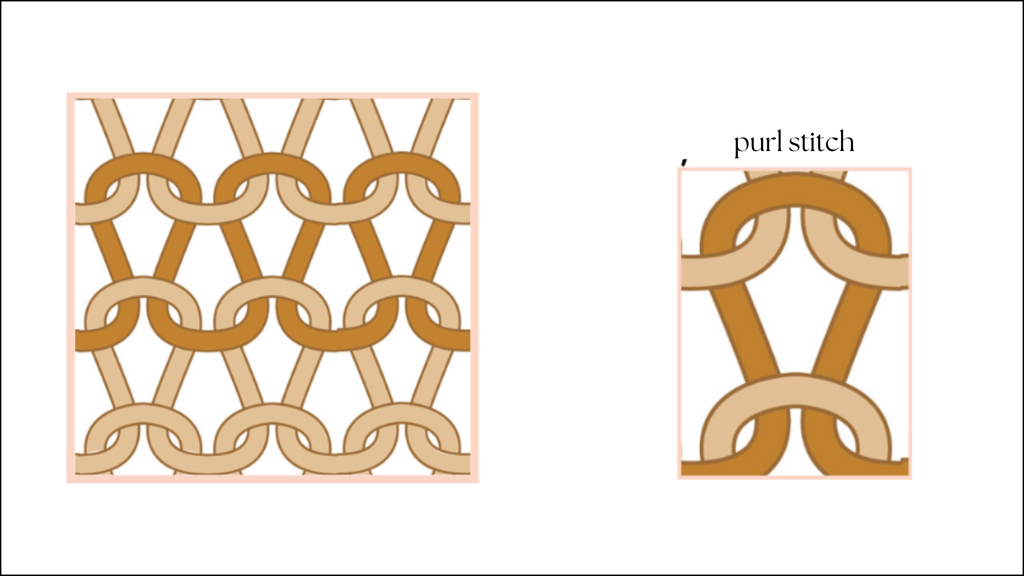
Next, most knitters usually learn the purl stitch. The purl stitch is just like the knit stitch, but the opposite. The yarn is pulled from the front to the back. Purl stitches are even sometimes called reverse knit stitches.
Miss Stitch

A miss stitch is made by literally missing a stitch. This happens when a knitting needle misses a stitch and does not make a new loop in the current course that is being knit. Instead of a loop forming the yarn just passes, or floats behind the stitch. That is why we call yarn passing by stitches but not forming new stitches floats.
Miss stitches are important when designing knit patterns with colors. The use of miss stitches will increase the fabric weight, and reduce stretch and fabric width.
Tuck Stitch
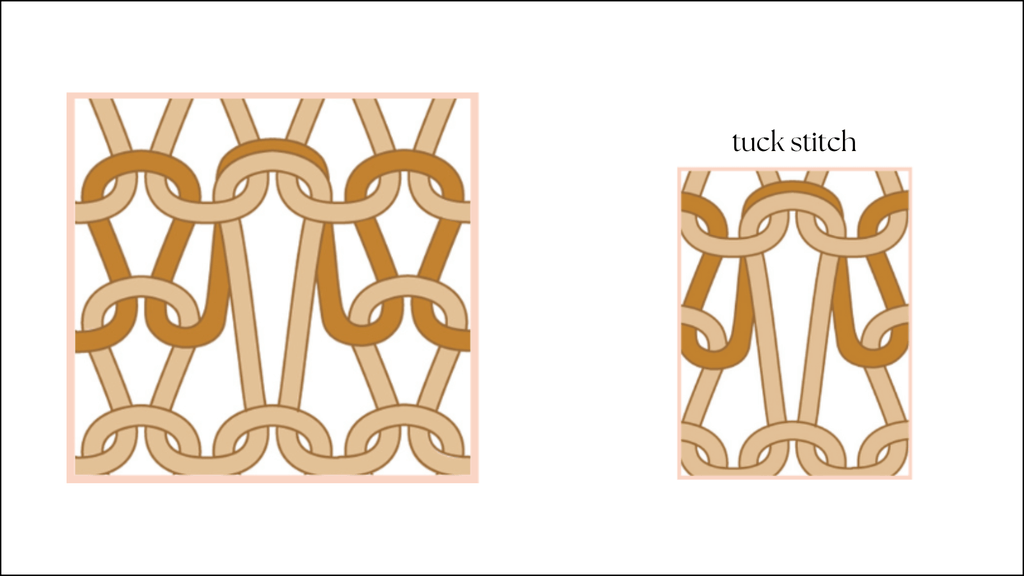
A tuck stitch is when a stitch is made, and instead of releasing the stitch, the needle holds onto it. The effect is an elongated stitch that stretches through multiple courses.
Tuck stitches help in creating designs with different colors. But, they are mostly useful for texture or eyelet effects in the fabric. Adding tuck stitches to a design will increase fabric weight, fabric width, and the thickness of the fabric.
Weft vs warp knit fabrics
There are two main types of knit fabrics. They are warp knits and weft knits. Each type of knitting produces totally different types of fabrics. For example, sweaters and t-shirts are weft knits, while laces and hosiery are generally weft knit.
Next week we will talk more about warp knits, which can get super confusing.
making weft knit fabrics
In knitting, weft knit fabrics are knit by building the fabric horizontally, course by course. While hand-knit sweaters are a form of weft knitting, right now we are going to talk about weft knit fabrics that are made on industrial machines.
As a rule, in weft knitting, all loops in a course of fabric are made with the same yarn. And, weft knit fabrics can be made on both flat and circular knitting machines.
Circular knitting machines

In a circular knitting machine, all of the needles in the machine form a circle. The yarn that is forming loops for the course makes its way around each needle of the machine and then goes around again. The result is rows or courses in a spiral that form a tube of fabric. Kind of like a slinky.
The tube is then cut open to make one flat piece of fabric.
Flatbed knitting machines
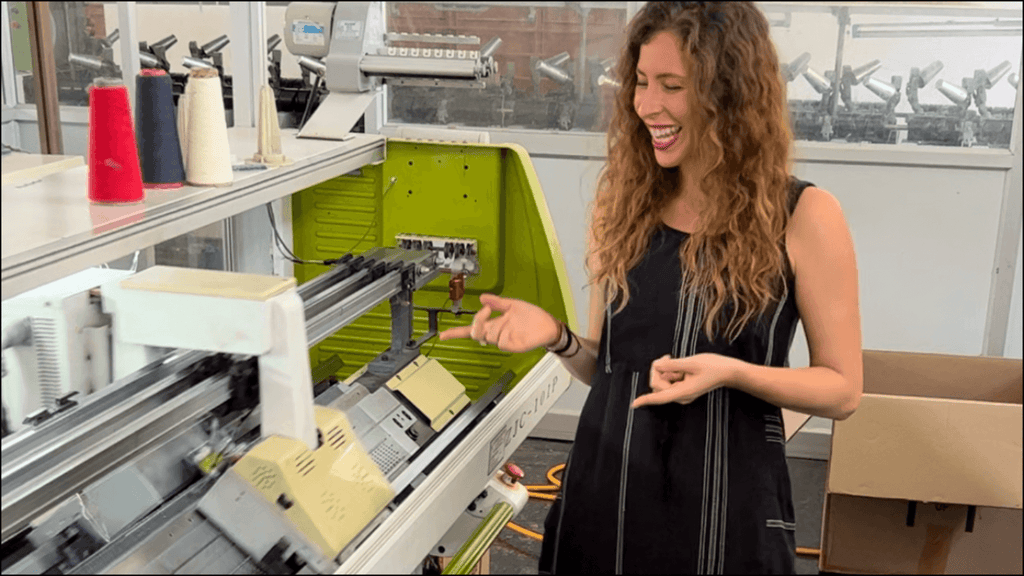
On a flatbed knitting machine needles are in a straight line. A yarn is fed all the way across, and then turns around and goes back the other way, kind of like the weft yarns in a woven fabric. The needles move in a straight line, like a typewriter.
Why do t-shirts always twist?
In wovens, we learned about why the legs of our denim jeans twist. Have you ever noticed the same thing happen to your t-shirt? Does one seam always wiggle its way forward? Well, unlike jeans it is a not sewing problem, this is actually a fabric problem.
Remember how circular knitting machines knit in a spiral, with stitches wrapping around like a slinky? This creates a natural curve, or skew in the fabric. When the fabric is cut into a garment this curve is still there, and causes to one side.
Basically, the fabric wants to return to the original circular slinky shape that it was knit in.
There is no workaround for this. This is just the nature of circular knit fabrics. There are some finishes that help to minimize this effect, but ultimately it will always be a problem.
don't be fooled
Manufacturers are pretty clever. They have created finishes, and use special techniques to press t-shirts straight. But, once you buy them and wash them, the fabric relaxes, goes back to its natural state, and you are left with a shirt that no longer fits quite right.
So, if we are creating the best white t-shirt possible, what should we do?
The solution is using a flatbed machine, where each row neatly stacks on top of the next. Knit fabrics made on flatbed knitting machines do not have this curving problem.
The only downside is that this process is much slower. So flatbed knit fabrics tend to come at a much higher premium. Read - cost more money.
Types of Weft Knit Fabrics
There are three different types of weft knit fabrics, they are jersey knit fabric, rib knit fabric, and purl knit fabric. Hint, the names of the fabrics have to do with the stitches in them. And every type of knit fabric falls into one of these three categories.
All of the photos I have that illustrate each type of fabric are from Wool And The Gang. If you want to teach yourself how to knit by hand, they have amazing tutorials. And, they are great for this blog because the photos use big chunky yarns that make stitches easy to see.
When we start discussing what makes the best white t-shirt, understanding all 3 of these types of knits will be important.
Jersey knit fabrics
This is the most basic type of knit fabric. A jersey knit fabric has all of the knit stitches facing towards the front. Jersey knit fabrics are easy to spot because they have smooth faces with each stitch looking like a "v", and the back of the fabric has a horizontal scallop pattern with a lot of texture.
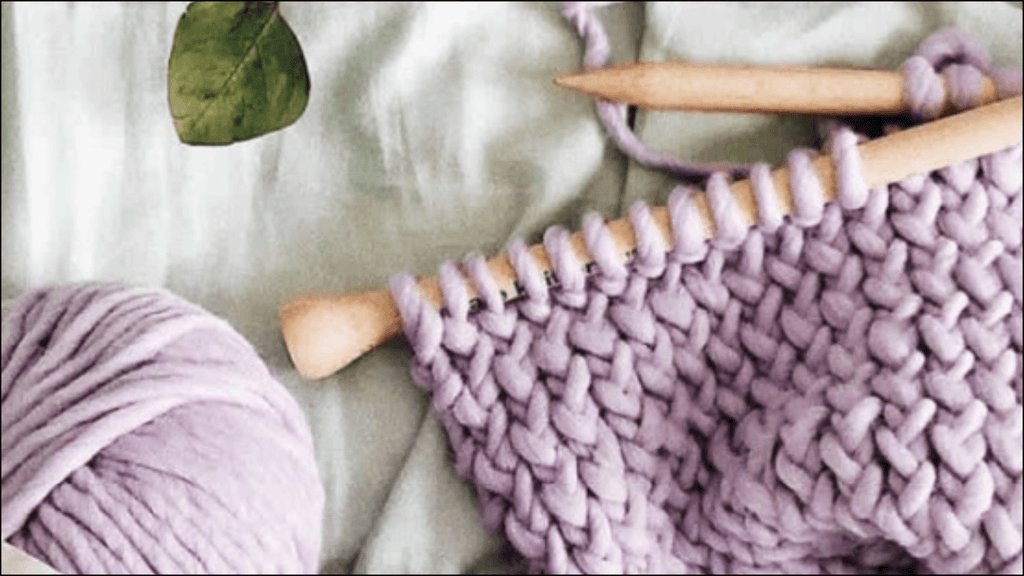
These are the most popular of the knit fabrics, and the fastest to manufacture. An example of a jersey knit is a basic sweater.
Jersey knit fabrics are fast to make because they only require a single needle bed, and are the simplest. And, circular knitting machines are much faster than flatbed knitting machines.
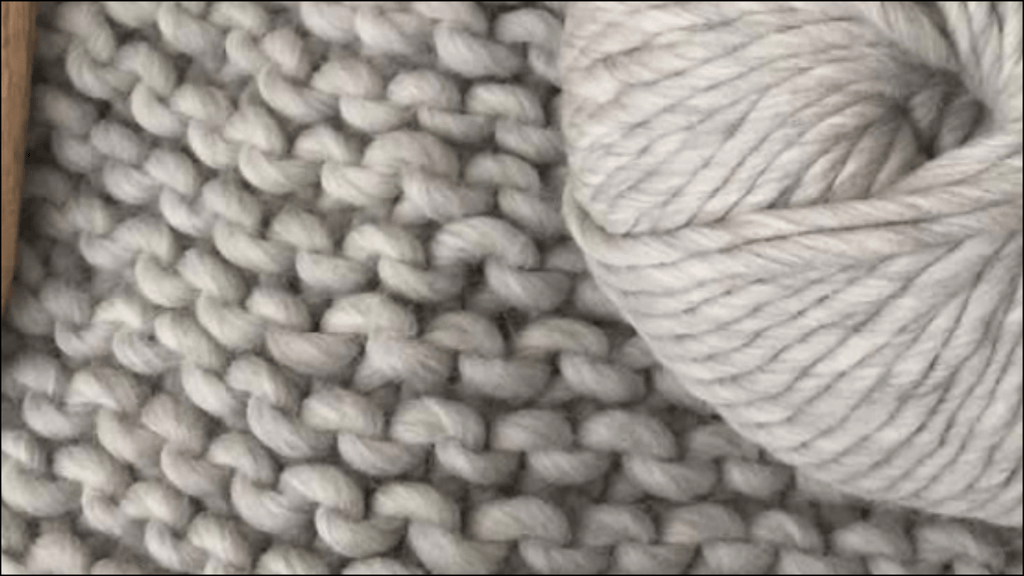
Identifying a jersey knit
All knits on the face, and all purls on the back.
Characteristics of all jersey knits.
All jersey knit fabrics are unbalanced, no matter what type of machine is used. Because all of the stitches are on one side, and the purls on the other, all the loops pull to the face of the fabric. And, this will cause the fabric to curl under.
, no matter what type of machine is used. Because all of the stitches are on one side, and the purls on the other, all the loops pull to the face of the fabric. And, this will cause the fabric to curl under.
Also, much like a woven if one yarn breaks, you have a big problem. One broken yarn will cause all of the loops in that course to unravel, creating a run.
Rib knit fabrics
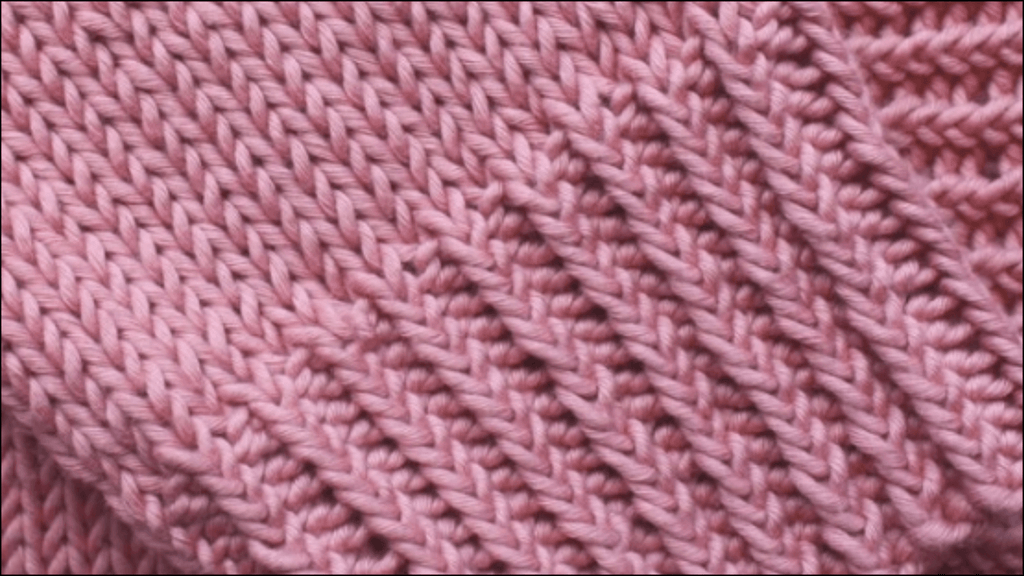
Rib knit fabrics have both knit and purl stitches on the front and back. One wale can either contain knit stitches or purl stitches. Never both. This means that 1 wale will only have either knit or purl stitches. The wales will then alternate between knits and purls across the width of the fabric to create stripe (rib) patterns.
These fabrics need a special knitting machine. Because there are both knits and purls on each side, a knitting machine with two sets of needles (one for the front and one for the back). The fabric is knit between the two beds.
These machines are theoretically twice as complex and are slower at producing fabrics than a single needle bed jersey knit machine. Read, rib fabrics will be more expensive than jersey (generally, holding all other variables constant).
So, if a fabric has two wales of rib, then 2 wales of purl, that then repeats - this fabric is a 2x2 rib. The naming of these fabrics works similarly to how we name woven fabrics. But what about a 3x1 rib? A 3x1 rib has 3 wales of knits, and 1 wale of purl on its face. Remember, the technical face of the fabric is always the one with the most knit stitches.
Identifying a rib knit
A rib-knit fabric can sometimes be hard to analyze, the best way to see what is going on is to stretch the fabric out to separate the wales. The knit stitches will be raised, and the purl will be indented.
Characteristics of rib knits
Because there are knit and purl stitches on both the face and the back, rib fabrics tend to have more balance. And, do not curl the way jersey knit fabrics do. Rib knits also have a lot more stretch and recovery then jersey knits.
Let’s go back to designing our perfect white t-shirt.
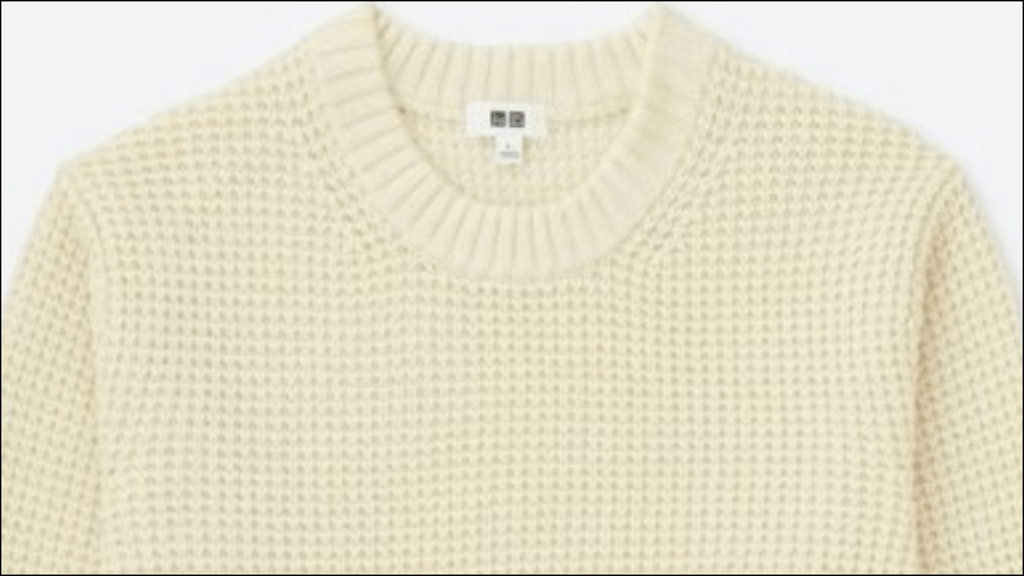
The fact that ribs have very good stretch and recovery is why rib knits are often on necks and cuffs of a garment. These areas tend to need extra stretch to accommodate fitting your head and hands through. When shirts are made with self-fabric (plain jersey the same as the rest of the shirt) instead of rib, you will often find your neck and openings around the sleeves will stretch out quickly. Having a self neckline will save money, but ultimately it will diminish the quality of the shirts over time.
Purl knit fabrics

In a purl knit fabric a wale can have both knit and purl stitches (remember, ribs are one or the other).
The most basic purl knit fabric a 1x1 purl, this means that the first course is all knit stitches, and the second course is all purl stitches, and then the cycle repeats. A 2x2 purl is 2 courses of knits and then 2 courses of purls before repeating.
The fabric in the image above is of a 4x3 purl fabric, and technically we are seeing the back of the fabric (the side with the most purl stitches) in the photo.
Purl knit fabrics need a special type of machine. These machines are purl kitting machines aka links-and-links knitting machines. These machines can be circular or flatbed. Purl knitting machines have one set of double-headed needles that move between two needle beds. These are the most complex of knitting machines. And you guessed it, the slowest, and most expensive.
But, these machines are versatile. Purl knit machines have setting options to also produce both plain jersey and rib fabrics.
Identifying a purl fabric
To tell if a fabric is a purl fabric, the stretch is lengthwise to separate the courses. Purl courses will be raised, while knit courses will be recessed.
Purl fabrics are also a way of creating texture fabrics without the use of tuck or miss stitches.
Characteristics of purl fabrics
Purl fabrics tend not to curl the way jersey fabrics do because they have more balance.
Purl knit fabrics are usually found in outerwear like sweaters, and thus not relevant to our best white t-shirt example.
Specialty knit fabrics, interlock – a special type of rib
Interlock knits are a special type of rib knit and are made on an interlock machine. An interlock rib is basically a double layer fabric. If there is a wale of knit stitches, directly behind it there will be a wale of purl stitches. This creates a wale with knit stitches showing on the face and the back.
Identifying an interlock fabric
To determine if a fabric is interlock stretch it widthwise to separate the wales. If you see two rows of loops at the top of the fabric directly lining up it is an interlock. If the two rows of loops do not directly line up, then it is just a regular rib fabric.
Also, try stretching it to separate the wales, if it looks like a knit jersey fabric on both sides, it's probably an interlock fabric.
Characteristics of interlock fabrics
Interlock knits are smoother, and more stable than regular ribs. They don't stretch out, and are very stable. They are also great at insulating.
For these reasons they are the optimal fabric for the best white T-shirt. And, generally the most expensive.
How to Design a Luxury white t-shirt
So if you were truly designing a luxury white t-shirt, interlock fabric would be a must. And, of course, interlock made on a flatbed machine, not a circular knitting machine to prevent seam twisting.
You would then want to have a 1x1 rib (2x2 ribs can look too chunky) our the neckband to ensure the neck would not stretch out after multiple wears.
Product Development is a process...
Do you see how all of this is starting to come together? Hop back to these posts on fibers, and yarns, and think about how selecting ultra fine luxury Supima cotton could take this best white t-shirt to an even more luxury level.
Or, maybe blending with a bit of polyester to add stability and help the fabrics withstand even more wear and tear.
How would you design the best white t-shirt? What criteria is important to you?
Remember, real luxury and quality products need to be built step by step through the entire supply chain. If a company claims they have the “ultimate white t-shirt” now you know what questions to ask to see if they are putting out a quality product or just full of flashy marketing gimmicks.
The best white t-shirt challenge
Let’s break down our perfect t-shirts, and because I own them all already I’ll include my wash and wear reviews. My uniform is basically a t-shirt and jeans.
I just don't get the hype - Re/done

Main fabric
Jersey
Neck
Self jersey
Fiber content
100% cotton
BUT! Look at this tricky language...
"The tee shirts are made with our exclusive 100% Modern Cotton, knitted and sewn entirely in the USA. The Modern Cotton has the feel of a deadstock vintage tee that has never been worn before."
This is greenwashing. Notice they say "has the feel" not "is vintage deadstock".
Wash and wear
There is nothing special about this shirt. And, I don't know why it continually is on roundups as one of the best white t-shirts on the market. It is cheaply made. But, the marketing makes you think it is luxury. This is a great example of a brand that spends its dollars on flashy marketing instead of investing in the product.
3rd PLACE - Madewell
honorable mention - best white t-shirt for comfort
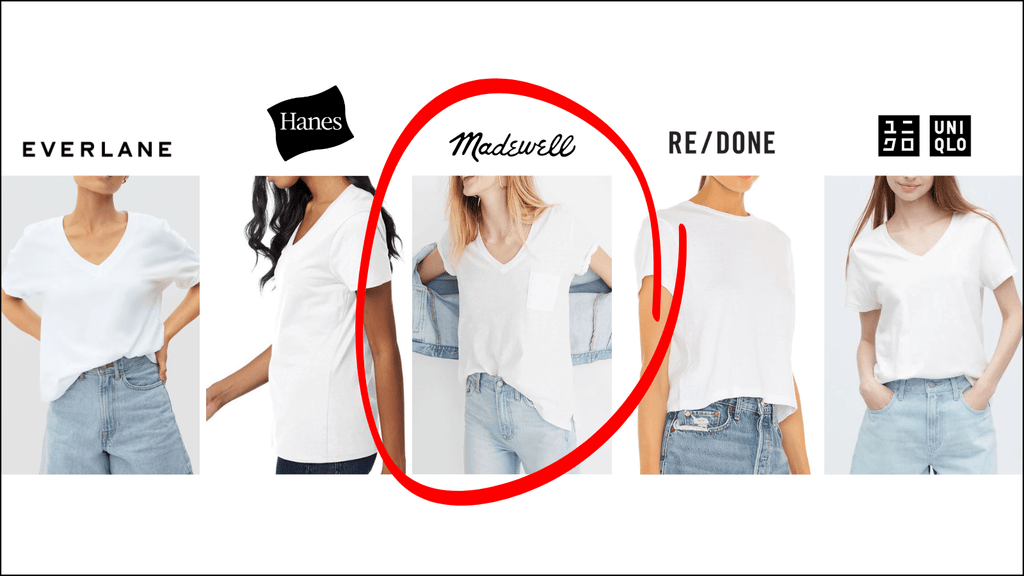
Main fabric
Jersey
Neck
Jersey
Fiber content
100% cotton
Wash and wear
Like Madewell jeans, this shirt is going to twist after one wash, and after a few wears, the neckline starts to get wavy and stretches out.
Points for comfort. I bought a few of these shirts about 3 years ago when they were on sale. Now that they are all stretched and twisted I use them as pajamas in the house.
Madewell always comes so close to making a quality product. They put in 80 percent of the effort to make a quality product. But then, cut corners that compromise quality to save a few cents in their margin.
2nd PLACE - Hanes
honorable mention - best white t-shirt for affordable price

Main fabric
Jersey
Neckband
Rib
Fiber content
100% cotton, ring spun
Ring Spun cotton illudes to higher quality fibers and yarns.
Wash and wear
The cotton doesn’t hold up after multiple washes and starts to look dull and pills. These shirts are affordable, but do not last. Full disclosure I would buy a pack every time I didn’t feel like doing laundry in college. Most of the shirts never made past one semester because they would wear out fast.
1st PLACE - Uniqlo
My personal favorite white T - best white t-shirt for luxury fibers
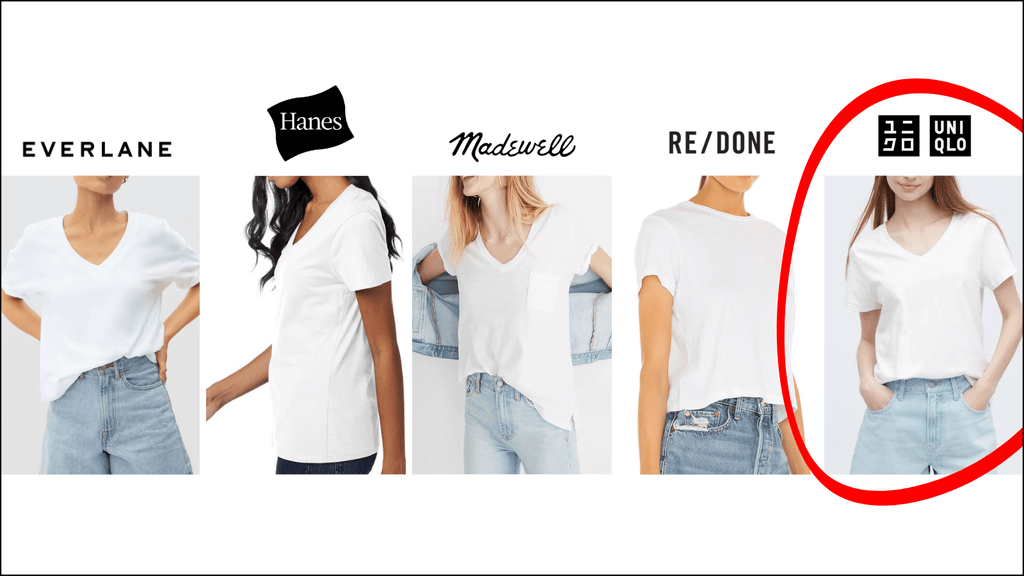
Main fabric
Interlock
Neckband
Interlock is a much better option than jersey knit fabric. But, over time, it will not perform as well as rib. Uniqlo also chooses to use self interlock for the neckband to cut costs. While the fabric might be more expensive than a rib, logistically using the self on such a small area of the shirt will be cheaper than having to source a second fabric for the shirt.
Fiber content
100% cotton, pima
Pima cotton has longer staple lengths, produces a superior yarn, and much more luxurious fabric.
Wash and wear review
I have owned this shirt for a little over a year and it’s still going strong. Fabric and neckband are looking as crisp as the first day I bought the shirt.
THE MOST SUSTAINABLE WHITE T-SHIRT - EVERLANE
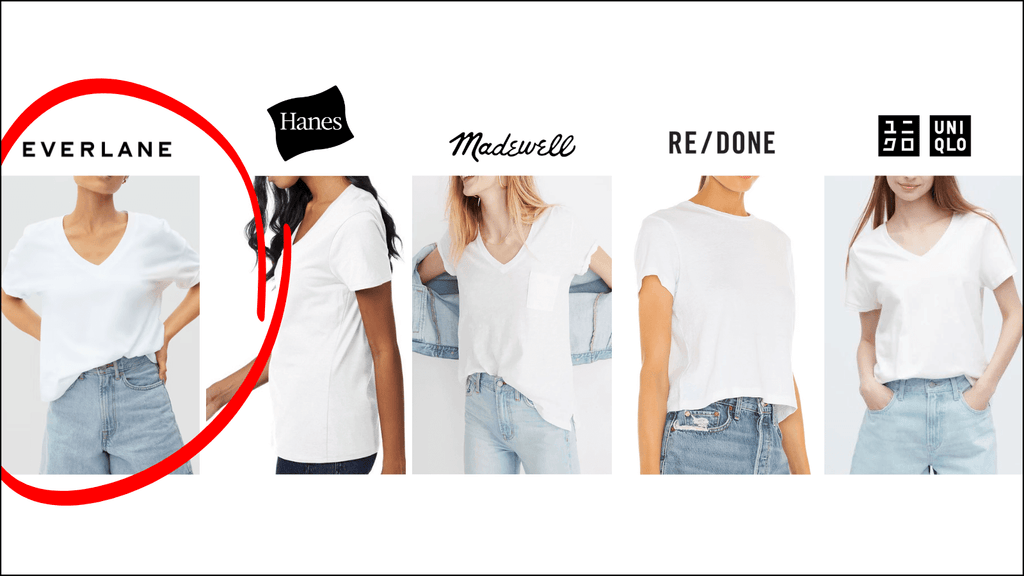
Main fabric
Jersey
Neck
Self, jeresy
Fiber content
100% organic cotton
Wash and wear
The fabric is heavy weight, and while corners were cut on the design (no rib in the neckline) to me it looks like they reinvested that money back into the weight of the shirt fabric.
The other thing I like is that at $30 (by the way they go on sale freqntly for as low as $22), Everlane is making organic main stream

2 comments
This is SO AMAZING AND INTERESTING!!! thank you so much!!!!
Very nice and informative reading in a simple way.
Regards
Leave a comment